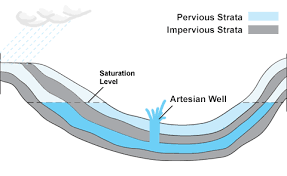What are artesian wells and how are they different from man-made wells?« Back to Questions List
|
An artesian well is a well in which pressurized water naturally rises to the surface. As early as 12th century, artesian wells were discovered by the French. When they were dug, water rose to the surface under pressure and even gushed into the air. Similar wells found elsewhere were named Artesian wells. An underground layer of water-bearing permeable rock or gravel/sand or silt from which groundwater can be extracted using a water well is called an aquifer. These wells exist only under certain conditions. First the aquifer must be tilted, sloping down to considerable depth. And it must be sandwiched between two impervious layers. Surface water seeps into the upper end of the aquifer and moves slowly through it. Trapped between the impermeable layers, water towards the bottom of the aquifer is under tremendous pressure because of weight on top. When a well pierces the impermeable layer above the aquifer, the pressure is released and water gushes up. If the pressure is great enough, water may spurt into the air in a spectacular fountain. Man made well water is drawn from a protected well that taps directly into an unconfined aquifer. Water must be pumped through a pipe by means of an electric or hand pump. Artesian springs operate in the same way. But instead of escaping through man-made wells, the water rises to the surface through natural breaks that occur in the cap of impermeable rock.
Which is the brightest of all objects seen in a night sky?What is the ring of fire?
|

